
Evolv Agro
Available Sizes: 5 – 13.5 US Men’s (including half sizes)
Reviewer Street Shoe Size: 13
Size Tested: 13
Construction:
- Upper: Synthetic (SYTHRATEK VX)
- Liner: Microfiber
- Midsole: TPS: Tensioned Rubber, Dark Spine Heel
- Sole: 4.2 mm Trax SAS
- Closure: Velcro “Adjustable Strap Length Closure”
MSRP: $165
Test Locations: Rifle, Clear Creek Canyon, & Eldorado Canyon, CO; Ten Sleep, WY; Kraft Boulders, NV; Moe’s Valley, UT
Days Tested: 25
Intro
The Evolv Agro, which recently replaced their discontinued Nexxo, is the most aggressive and specialized shoe in Evolv’s line. And while the Agro might initially look like a close relative of the Evolv Shaman that’s got a little more downturn and has then been dipped in a generous amount of sticky rubber, in reality these shoes are more different than one might think.
The Agro is actually pretty different compared to most of the new aggressive climbing shoes that have recently hit the market. So how well does the Agro perform on steep climbs and boulders? And could there be such a thing as a shoe with too much sticky rubber? After a full season of climbing in the Agro, I’ve got a good sense of the shoe, how it compares to several other shoes in its category, and finally have the answers to these questions.
Geometry and Features
Like most steep sport-climbing or bouldering shoes, the Agro has an aggressively downturned shape. The Agro is more downturned than the Evolv Shaman and comparably shaped (in terms of downturn) to the La Sportiva Solution.
But where the Agro differs from most other aggressive shoes is in its modest degree of asymmetry. In this regard, the Agro is more similar to the Scarpa Instinct VS than some other high-end sport and bouldering shoes like the Scarpa Drago or La Sportiva Testarossa and Genius. The Agro’s combination of aggressive downturn and moderate asymmetry makes it a bit more versatile when it comes to fitting a greater variety of foot shapes while still maintaining a downturned shoe’s ability to hook into pockets or in-cut edges on steeper terrain.
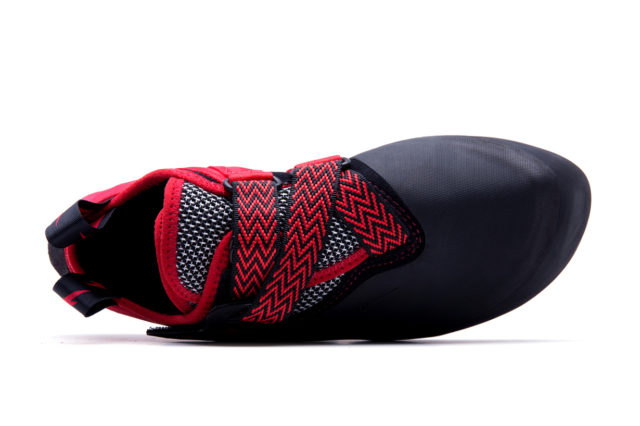
The Agro’s toe box tapers moderately from the outside to the toe and has a pretty sharp bevel on the vertical dimension (i.e., the slope that covers your toes from the tip of the shoe to the upper). This is again similar to the Solution (which is possibly the most apples-to-apples comparison to the Agro), and in contrast to shoes like the Five Ten Hiangle and So Ill Street, both of which have more rounded toe boxes.
Aside from the Agro’s closure and split tongue, the upper itself is almost entirely covered in Evolv’s proprietary Trax SAS climbing-grade rubber. This is the same rubber that appears on the Agro’s sole and heel, and it’s very grippy.
The Agro’s toe box also features what Evolv calls the “Tension Power System” (aka, TPS). This is a tensioned midsole that is meant to maintain the downturned shape of the shoe. The TPS midsole is the layer between the actual outsole and the fabrics that touch your foot, not to be confused with the center of the sole (the red part on the Agro) that separates the forefoot from the heel. The TPS on the Agro is effective at maintaining the shoe’s downturned shape, and functionally is quite similar to the P3 platform that is used to add stiffness to many La Sportiva shoes like the TC Pro, Genius, and Solution.
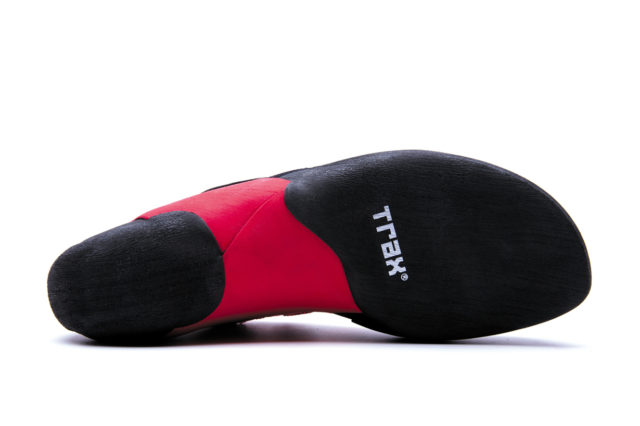
The Agro’s split tongue feels comfortable, and the two parts of the tongue have plenty of overlap so they don’t bunch up or rest their stitching right on the top of my foot. The Agro’s closure consists of a single “slingshot” strap (see photo below). This style of closure was popularized by the Solution due to its ability to more evenly distribute pressure than some more traditional velcro closures, and it now appears on several other shoes like the Agro, Tenaya Mundaka, and La Sportiva Genius.
The Agro’s buckles are metal and seem to be sewn thoroughly into place. After around 25 days in the Agro, I haven’t even come close to having any part of its closure system fail. But I think the best part about the closure on the Agro is the adjustable length provided by a buckle at the base of the strap. This allows you to tailor the strap length to accommodate your foot volume, thereby avoiding problems like the Velcro on the strap over- or under-reaching its counterpart patch on the side of the shoe. (This is a problem I’ve run into with the Mundaka where the strap is too long and fully tightening down the shoe means that the Velcro doesn’t make full contact.)
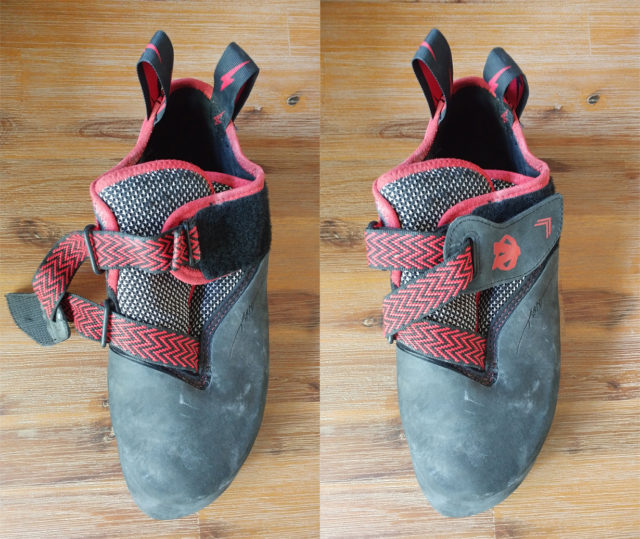
Finally, the Agro is noticeably tapered from the heel to the forefoot, with a relatively wide toe box but a narrow, tight-fitting heel. I have medium-volume feet and didn’t find the Agro to be uncomfortable, given how aggressive it is. And beyond just being comfortable, I found that the Agro inspired a lot of confidence on heel hooks, something that is absolutely essential for any shoe that caters to boulderers.
Fit
I wore the Agro in my street shoe size of 13, and I felt it was exactly the right fit for the shoe. Most of the power in the Agro comes from its downturn and stiffer forefoot. The tall toe box allows for some flexibility in the fit and you could probably go down a half-size without incurring serious discomfort. But I wouldn’t advise going too much smaller than that, at least to start (obviously size down or up as far as you need to in search of a fit that minimizes dead space without being painful).
The other important consideration here is that the Agro stretches probably the least of any shoe I’ve ever worn. Not only is the upper made of a non-stretchy synthetic (and vegan) material, but there’s also rubber covering so much of the shoe that it has very little potential for stretch to begin with. In other words: with the Agro it’s important to get the right fit straight away.
Performance
The Agro is expressly designed for steep climbs and boulders and it works very well in those areas. The Agro’s generous downturn and lack of really aggressive asymmetry make sense for overhanging terrain. On overhanging climbs, such as steep cave climbing, you really need to be able to hook your toes into pockets or edges but your body is much further from the wall so you’re more likely to be toe-ing in on holds with your feet straight-on.
Compare that to vertical (or less than vertical) terrain where you’re keeping your hips close to the rock, so you’re working more with your front-inside edge, rather than the tips of your toes. In this latter scenario, it helps to have some inward tilt (aka, asymmetry) to the shoe — since the shoe is close to parallel with the surface of the rock, the slight inward turn helps you get more purchase on pockets or edges that aren’t facing the optimal way.
The bevel on the Agro’s toe box functions much like the toe box on the Solution and provides a high degree of precision, particularly when the terrain is steep.
Having so much rubber on the front of the shoe took me a while to get used to, but I understand the benefit when it comes to toe hooks. The idea here is that if you can get the top of the shoe anywhere near the hold, you’ll make contact with sticky rubber rather than fabric. The Agro’s extra rubber is effective in this regard, but all that rubber does add rigidity to the toe box and decreases sensitivity during those toe hooks.
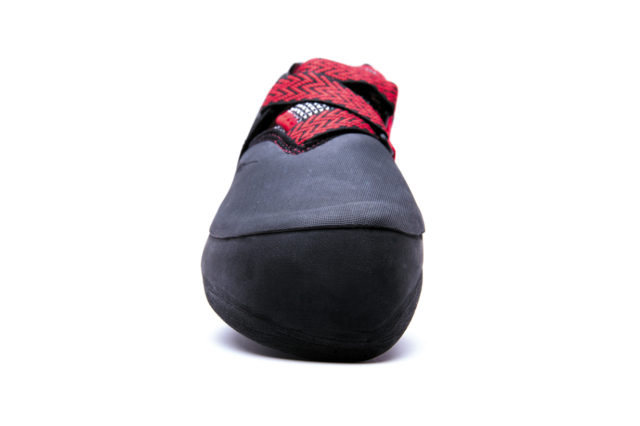
On the topic of rigidity, Evolv claims that the “tensioned rubber midsole maintains downturned shape with incredible sensitivity.” I’m not entirely convinced on the last part of that statement. It’s true that the Agro has some features designed to boost the shoe’s sensitivity, such as its “split sole” (there are separate forefoot and heel patches of rubber, rather than one continues slab) which increases flexion at the midfoot. Additionally, parts of the rand in the front of the toe box are thinner than others, which are meant to increase sensitivity while still protecting high-use areas from quick erosion.
The flexible arch does lend some flexibility to the shoe which allows it to straighten out a bit when you need to (e.g., when you’re standing on your tiptoes to reach a hold) without causing the shoe to slide off the hold. I haven’t found the variable-thickness rand to be quite as easily noticeable since I typically notice sensitivity in the “high wear zones” that have thicker rubber anyway.
All that said, the Agro isn’t horribly stiff or unbearably insensitive. After all, many of La Sportiva’s shoes can feel quite stiff between the P3 plate often found under their toes and their often slender, aggressive shapes. I don’t think the Agro is particularly less sensitive than, say, the La Sportiva TC Pro or Butora Altura, though those are both shoes designed for trad climbing, where stiffness is more common.
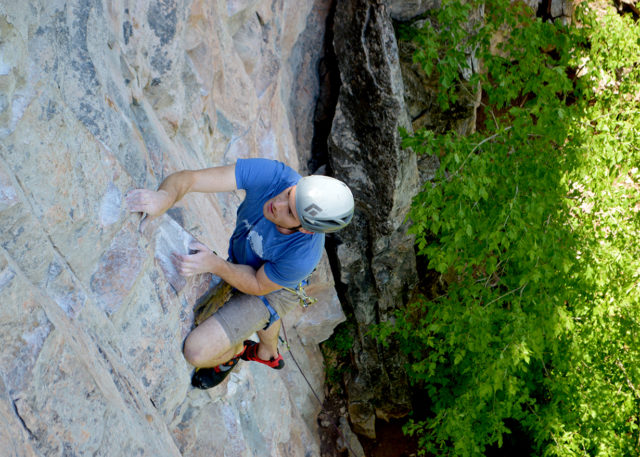
The Agro is may be slightly less sensitive than the Solution, though not dramatically so. In terms of broader performance characteristics, the Solution handles vertical edging better than the Agro, but both shoes perform quite well on really steep terrain.
I’d say the Agro is stiff relative to most other high-end sport and bouldering shoes, and I would definitely not agree with Evolv when they say the Agro offers “incredible sensitivity.” For truly high-level sensitivity, I’d recommend checking out the Five Ten Hiangle, Scarpa Drago or Furia S, or Tenaya Mundaka. Granted, those are all different shoes for a variety of reasons, and there’s nothing inherently wrong with less sensitivity in a shoe — it’s all personal preference.
So it just comes down to knowing what you want from a shoe. The Agro performs very well on edges and pockets on steep terrain, but definitely doesn’t prioritize sensitivity. This sets it apart from other modern bouldering shoes, which generally seem to be focused on greater sensitivity and softness (see the aforementioned Hiangle, Mundaka, Drago, and most of Scarpa’s performance line). So if you want an aggressively downturned shoe that is stiff and provides powerful power transfer off small footholds and don’t want a super soft, sensitive shoe, then the Agro is definitely worth a look.
Durability
This is an area where the Agro deserves credit. The Agro is made with robust materials at the closure, is covered with rubber, and offers enough precision that scraping your foot across the wall is definitely your fault. All this combines to make the Agro super durable, something that I think is often under-appreciated in consumable goods like climbing shoes. After 25 days climbing in the Agro, I haven’t yet had to take it in for a resole, and if there’s any trouble with resoling it given the full-rubber encapsulation of the toe box, I’ll come back and update this review. For now, though, full marks for durability.
Bottom Line
The Evolv Agro is a purpose-built shoe for steep climbing. It has mellower asymmetry than many shoes in its class and downplays sensitivity in favor of stronger power transfer when toe-ing in on edges and pockets, particularly on overhanging terrain. Assuming it fits your foot, the Agro is about as good at steep climbing as anything out there.
For climbers who frequent diverse terrain, you may want to consider whether or not you prefer a more sensitive shoe or a shoe with greater asymmetry before reaching for the Agro (again, this comes down to personal preference). But if those aren’t important factors for you, the Agro is an excellent shoe for steep climbs. The Agro also costs $160, which makes it more affordable than almost every other comparable high-end sport-climbing and bouldering shoe on the market. Add to that the Agro’s durable construction, and it’s a seriously high-value shoe for climbing hard, steep routes or problems.

Huh. I’ve owned Agros and Solutions and I think the Agros are much, much softer and more sensitive than Solutions.
That’s interesting- what size did you wear those shoes in? I wonder if there’s differentiation across the sizes. My experience was that the Agro allows for more mid-foot flexion, which is something you also get a lot of in softer shoes, than the Solution, but I didn’t find more sensitivity in the toe box. In this context I mean sensitivity strictly in terms of the resolution of sensation you get where your shoe interfaces with the rock. I never got to the point with the Agro that I could genuinely climb by feel, which is partly why I found it to be much better on steep terrain (where I don’t rely on that nearly as much) than on vertical or slabby terrain. As far as the Solution goes, the P3 platform, asymmetry, and less pliable mid-foot materials make for a stiffer feel or reduced foot mobility while standing on a hold, but I found them to be comparable in terms of how much I was able to discern of the holds I was standing on without setting my feet with my eyes every time.
Thanks for sharing your thoughts and experience!
What sizes do you wear in other shoes? La Sportiva, Scarpa for example.
My 5 cents. I’ve chosen Agro as an alternative to LS Solution that I have and use heavily.
Sizing – my street shoe size is 41 (UK7), Solution are 39 and decided to stick my street shoe size for Agro (i.e. 41EU, 7UK). It was difficult to put the shoes on for the first time even with thin plastic bags on my foot. But during climbing after the shoes were warmed up it was not so bad.
Comfort – the shoes are comfortable. Much more comfortable than Solution moreover Agro is not yet fully broken in. It’s not matter of size as visually Agro is few mm smaller than solution and also putting on the shoe is more difficult in case of Agro. So probably matter of inner lining and/or shape/fit. I expect the shoes will stretch little bit and I can even imagine to have it half size smaller but in this case issue will be put the shoes on.
Feeling – toe is softer than Solution and heel cup much tighter and sensitive. Feeling wise after session in Agro, heel cup on Solution is significantly baggy and insensitive.
Closure system – strap with adjustable length is very robust compared to Solution.
In a nutshell Agro is totally comparable to legendary LS Solution. Details that I mentions above are matter of personal taste.
I Bought Agros in my Street shoe size as recommended for Bouldering indoor and outs. But the AGRO does not have the knuckle box and due to that, it’s definitely one of those shoes I need to go 1 half-size maybe even full-size up from street shoe. But they don’t make 14’s & I can’t find a 13.5. Big feet make it SUPER hard to find a stylish and performance climbing shoe. Sadly I have big feet and this was just too small. KNOWING it doesn’t stretch I had to return them. But Evolv is definitely for a wider heal compared to 5.10’s Which are 2 sizes two small. Scarpa and La sportiva both only make maybe 3 shoes that come big enough for me. Even when ordering directly. For that reason I reccomend buying direct from Evolv or using Amazon Prime. To avoid return shipping fees. At least in the New Jersey, NYC, & PA area there are no stores that carry any shoes in my size with a moderate or aggressive downturn. Hence I still have yet to find a shoe that fits me right. I am hoping the Scarpa Veloce fits for indoor, & that the Evolv Oracles with Knuckle Box will fit in 13.5. I have 5.10 Primeaeon & Aleon in 13 & 14 BOTH are way too small, went back not because of length the 14 would fit perfectly if I didn’t have a huge gap in the heel because my heel is to big. Butora says made for Wide feet but like the AGROS the Butora GOMI for wide feet are not that sensitive & ACRO is sensitive but fits weird and both are really ugly. If you are a beginner looking for a shoe to grow with And climb gym only got medium heal and foot the Scarpa Veloce, if you have small foot Check out 2021 Vapor. Also, a comparable shoe to the AGRO not mentioned is the OCUN Bullit, this comes in size 14 and is much more sensitive with great grip. Just an idea. ALSO, So ill Does have WIDE toe box, but they have the narrowist heal and Quality Control for glue is less then perfect. But out of every shoe I have tried so far the closest to my actual streetsize were the SO ill TOPO the one in red. Sadly no size 13.5 or they’d be my go to top rope or gym sport climbing shoe. Right now I am considering the MAESTRO MID ECO for all around outdoor shoe & Evolv Oracle for Bouldering. But I have no idea if they will fit. Also Evolv Kronos is a good begginer to intermediate shoe.